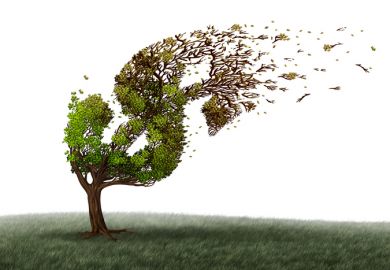Henry Kissinger defined an Iranian moderate as "a soldier who has run out of ammunition". Anoushiravan Ehtshami discusses Rafsanjani's policies without quoting the definition. It would not suit the author's gentle style although many in Teheran could match Kissinger's cynicism with their definition of an American radical.
After Khomeini is a Marxist professor's attempt to explain the rise of republican Iran under bearded authorities. The theme is urgent and spacious; the Iranian revolution was the most widely televised political event of the 1970s. Sadly, Ehteshami's style is academic and elitist.
There are redeeming features. Ehteshami has none of the dishonesty we find in the writings of exiled Iranian journalists living in a London or Paris flat while plotting a counter-revolution in their spare time. Nor does the author suffer from the over-refinement so evident in the political antics of Iranian diplomats who need to defend their government's every move.
Ehteshami surveys various conspiracy theories seeking to explain the fall of the Shah. Two of these deserve mention. The Monarchist camp was headed by Shahpour Bakhtiar - assassinated by Khomeini's lieutenants in Paris in 1990. This group saw the hand of international communism, especially the Soviets, in the plot to overthrow Iran's ancient monarchy. But outside the realm of fiction, it is stressful to imagine Iranian clergymen enjoying a friendly relationship with KGB agents. The other view, popular among conservative Sunni Muslims, is that the CIA engineered the Ayatollah Khomeini's rise to power in order to establish dissident (Shi'a) Islam as a sovereign power!
There are three crucial factors, not mentioned by Ehteshami which help to explain the Islamic revolution. First, the Shah, like Ataturk before him, showed open contempt for Islamic symbolism in public life. This attitude provoked the masses. The Arab regimes show Islam plenty of rhetorical support while concealing their contempt. Second, the Iranian clergy opposed the Latinisation of the Persian alphabet; secular Turkey was a warning. Third, the clergy vetoed the proposed replacement of the Islamic calendar with the Iranian Imperial calendar. Islam would count the centuries.
Despite his death in June 1989, Khomeini remains at the helm of Iran's religious destiny. Does theocracy work? Ehteshami answers that post- revolutionary Iran is now an ordinary state desperately seeking re-integration into the capitalist world order. (In Khomeini's day, the slogan was: "Neither East nor West.") But there is surely a difference between integration on alien terms (dictated by foreigners) and integration on domestic Iranian terms. In the Second Republic, every economic, foreign and political policy is actually a surrogate for a theological position. The author's Marxist persuasion prevents him from noting the enduring achievement of Khomeini's militancy.
Admittedly the religious dimension is not always taken seriously in Iran. But the label "religious" is not always a euphemism for "irrelevant" in Teheran, unlike in London, Washington or Cairo.
Ehteshami laments the chaotic inefficiency of the new Iran. But the Persian temperament has always felt at home only in systems with a bit of disorder. Bureaucratic incompetence, however, is found in every Muslim country, including ones that are politically stable. Indeed Iran's clergymen are better bureaucrats than their secular counterparts in developing countries: there is much less corruption and bribery in Iran than in Pakistan. Ehteshami does not make the comparison.
Ehteshami has no faith in the ayatollahs. They are portrayed as victims of standard prejudices about the West. Yet the ayatollahs are dead right in rejecting that tiny western sub-culture comprised by American politicians. Iran's secular critics are generally victims of their own pretentiousness. They are all in favour of something called western civilisation even when their own acquaintance with Voltaire, opera and democracy is evidently slight.
The Iranians are thus a nation divided. The revolution was partly a civil war - as Ehteshami notes. Those who lost out are now in exile. For them, as for the author, the Second Republic is a failure. But private depression over the loss of a homeland is not to be mistaken for objective political commentary. Republican Iran is, Israel apart, the only potentially mature democracy in the region. The surrounding Arab states are all feudal monarchies and dictatorships. And all are a force - as the Israelis know.
Iran, however, is a regional superpower. Like a meddlesome relative, it interferes without apology in the internal affairs of Gulf Arab regimes with sizable Shi'a populations. In the Lebanon too, Iran has decisive influence. Ehteshami guides us through the intricacies of tribal squabbles in that political mess we politely call the Middle East. But he offers neither critical perspectives nor strategic predictions.
Finally, back to Khomeini. Ehteshami describes the ayatollah in devout idiom: "the patriarch", "the Imam", "the Leader". None of it conveys either the man's uniquely photogenic charisma or his authentic conviction. As with Nelson Mandela, we see a confident economy of movement, a fixed radius of political vision.
Khomeini is not Ghaddafi or Arafat. Here is no personal bravado masquerading as moral courage. Even Egypt's Nasser - the successful version of Saddam Hussain - is finally a failure. History may not give a favourable verdict on Khomeini. But he did die a natural death; and, in the eyes of many Muslims, he died in righteousness too.
Shabbir Akhtar teaches Islamic studies at the International Islamic University, Malaysia.
After Khomeini: The Iranian Second Republic
Author - Anoushiravan Ehteshami
ISBN - 0 415 10878 0 and 10879 9
Publisher - Routledge
Price - £40.00 and £13.99
Pages - 244
Register to continue
Why register?
- Registration is free and only takes a moment
- Once registered, you can read 3 articles a month
- Sign up for our newsletter
Subscribe
Or subscribe for unlimited access to:
- Unlimited access to news, views, insights & reviews
- Digital editions
- Digital access to THE’s university and college rankings analysis
Already registered or a current subscriber?



